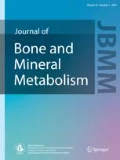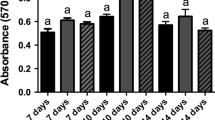Abstract
In this study, we focused on collagen metabolism as a factor involved in menatetrenone (MK-4)-related improvement in bone quality. Using rats with a congenital ascorbic acid (AA) deficiency, osteogenic disorder Shionogi (ODS) rats, we established a model in which abnormal collagen metabolism reduced bone mechanical properties, and investigated the effects of MK-4. We divided 13-week-old ODS rats into four groups: Pre, AA sufficiency (AA(+)), AA deficiency-control (AA(−)control), and AA deficiency+ MK-4-treated (AA(−)MK-4). MK-4 was given as a dietary supplement (30 mg/kg). At the beginning (pre) and after two, three, and four weeks, seven rats in each group were killed to measure plasma bone metabolism and femoral bone mass data and bone mechanical properties. In the rats killed after four weeks, histomorphometric data of the tibiae, the total amino acid level in bone collagen, and rates of proline and lysine hydroxylation were determined. In the AA(+)group, both the cortical bone mass data and bone mechanical properties were serially increased. However, in the AA(−)control group, the cortical bone mass data were similar for four weeks and the bone mechanical properties decreased after three to four weeks. After four weeks, the total level of amino acids in bone collagen and rates of proline and lysine hydroxylation were significantly lower in the AA(−)control group than in the AA(+)group. MK-4 increased bone mechanical properties after four weeks without influencing cortical bone mass. Simultaneously, it inhibited decreases in the total level of amino acids in collagen (P = 0.017). The rates of proline and lysine hydroxylation were higher in the AA(−)MK-4 group than in the AA(−)control group, but not significantly. These results suggest the level of collagen and abnormalities of hydroxylation are involved in the AA deficiency-related reduction in bone mechanical properties, and that MK-4 improves bone mechanical properties by restoring collagen metabolism.


Similar content being viewed by others
References
NIH Consensus Development Panel (2001) Osteoporosis prevention, diagnosis and therapy. JAMA 285:785–795
Cockayne S, Adamson J, Lanham-New S, Shearer M, Gilbody S, Torgerson DJ (2006) Vitamin K and the prevention of fracture. Systemic review and meta-analysis of randomized controlled trials. Arch Intern Med 166:1256–1261
Shiraki M, Shiraki Y, Aoki C, Miura M (2000) Vitamin K2 (menatetrenone) effectively prevents fractures and sustains lumbar bone mineral density in osteoporosis. J Bone Miner Res 15:515–521
Iwamoto J, Takeda T, Ichimura S (2001) Effect of menatetrenone on bone mineral density and incidence of vertebral fractures in postmenopausal women with osteoporosis: a comparison with the effect of ethidronate. J Orthop Sci 6:487–492
Ichikawa T, Horie-Inoue K, Ikeda K, Blumberg B, Inoue S (2006) Steroid and xenobiotic receptor SXR mediates vitamin K2-activated transcription of extracellular matrix-related genes and collagen accumulation in osteoblastic cells. J Biol Chem 281:16927–16934
Englard S, Seifter S (1986) The biochemical functions of ascorbic acid. Ann Rev Nutr 6:365–406
Peterkofsky B (1991) Ascorbate requirement for hydroxylation and secretion of procollagen: relationship to inhibition of collagen synthesis in scurvy. Am J Clin Nutr 54:1135S–1140S
Mizushima Y, Harauchi T, Yoshizaki T, Makino S (1984) A rat mutant unable to synthesize vitamin C. Experientia 40:359–361
Kawai T, Nishikimi M, Ozawa T, Yagi K (1992) A missense mutation of L-gulono-γ-lactone oxidase causes the inability of scurvy-prone osteogenic disorder rats to synthesize L-ascorbic acid. J Biol Chem 267:21973–21976
Togari A, Arai M, Nakagawa S, Bannno A, Aoki M, Matsumoto S (1995) Alteration of bone status with ascorbic acid deficiency in ODS (osteogenic disorder Shionogi) rats. Jpn J Pharmacol 68:255–261
Tsunenari T, Fukase M, Fujita T (1991) Bone histomorphometric analysis for the cause of osteopenia in vitamin C-deficient rat (ODS Rat). Calcif Tissue Int 48:18–27
Sakamoto Y, Takano Y (2002) Morphological influence of ascorbic acid deficiency on endochondral ossification in osteogenic disorder Shionogi rat. Anat Rec 268:93–104
Saito M, Marumo K, Fujii K, Ishioka N (1997) Single-column high-performance liquid chromatographic-fluorescence detection of immature, mature, and senescent cross-links of collagen. Anal Biochem 253:26–32
Harada S, Matsumoto T, Ogata E (1991) Role of ascorbic acid in the regulation of proliferation in osteoblasts-like MC3T3-E1 cells. J Bone Miner Res 6:903–908
Ishikawa S, Iwasaki K, Komaki M, Ishikawa I (2004) Role of ascorbic acid in periodontal ligament cell differentiation. J Periodontol 75:709–716
Goto A, Tsukamoto I (2003) Increase in tartrate-resistant acid phosphatase of bone at the early stage of ascorbic acid deficiency in the ascorbate-requiring osteogenic disorder Shionogi (ODS) rat. Calcif Tissue Int 73:180–185
Hara K, Kobayashi M, Akiyama Y (2002) Vitamin K2 (menatetrenone) inhibits bone loss induced by prednisolone partly through enhancement of bone formation in rats. Bone 31:575–581
Acknowledgments
We thank Ms Ikiko Mitome, Ms Haruko Yamauchi, and Ms Rumi Sato for their cooperation during the experiments and measurements.
Author information
Authors and Affiliations
Corresponding author
About this article
Cite this article
Hara, K., Akiyama, Y. Collagen-related abnormalities, reduction in bone quality, and effects of menatetrenone in rats with a congenital ascorbic acid deficiency. J Bone Miner Metab 27, 324–332 (2009). https://doi.org/10.1007/s00774-009-0069-3
Received:
Accepted:
Published:
Issue Date:
DOI: https://doi.org/10.1007/s00774-009-0069-3



